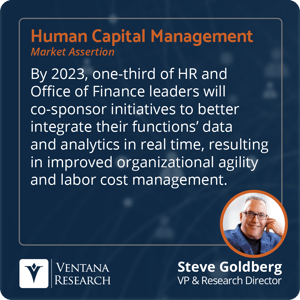Simply defined, an “HR-M&A lifecycle” is the sequence of critical workforce and HR-related activities and decisions that span due diligence through business integration after an M&A event is announced. Until recently, these potentially game-changing events were not the province or focus of HR technology offerings. This is due in part to HCM systems that, historically, were designed primarily to automate and optimize typical HR/HCM processes and events that occur throughout the year, to better understand and drive employee engagement, productivity and retention, and to mitigate workforce-related compliance risks.
As we know, M&A scenarios are neither regular events, nor are they usually governed by standardized HR processes. Frankly, even when not brought about by an M&A trigger, activities such as assessing organizational readiness and corporate restructurings have been beyond the scope and strengths of most HCM systems platforms. Many of the vital capabilities needed within an HR-M&A lifecycle are related to predicting, modeling, planning and analyzing not just data but also policies, plans and practices in a side-by-side manner, at both macro and micro levels.
These complicated dynamics became clear to me when, in the ‘90s, I was tasked with leading the “people aspects” of several global M&A deals in financial services from the corporate HR side, both in the U.S. and Europe. I learned firsthand why decades of industry research had attributed deal underperformance or outright failure to the inadequate attention given to the people issues. When it came to the need for targeted communications around integration plans, supporting broader change management efforts, or the ability to highlight key employee retention risks, my team realized that the leading HCM systems of the day were only a partial solution. And as I worked more closely with compensation and benefits leaders around modeling and harmonizing plans, pay practices and the associated costs—and with compliance teams on HR-related risk mitigations needed—the delta between technology available and how we needed it to flex to various requirements became even more pronounced, and more regularly addressed through ad-hoc means.
 So what has changed? I believe that now, many of the relevant capabilities outlined above are within reach. Five things in particular signal the tipping point:
So what has changed? I believe that now, many of the relevant capabilities outlined above are within reach. Five things in particular signal the tipping point:
- Years of customers voicing the need for solutions to be able to better support planning and modeling activities has made this more of a priority for HCM system solution vendors, and not just as it relates to M&A and business integration scenarios. Strategic workforce planning, total compensation planning and other HCM planning situations are also key. Are we there yet? Probably not, but we are much further along than we were. As one example, HR technology advances are paving the way for more collaborative planning across HR and Finance. We assert that by 2023, one-third of HR and Office of Finance leaders will co-sponsor initiatives to better integrate their functions’ data and analytics in real time, resulting in improved organizational agility and labor cost management.
- Intelligent virtual assistants that respond more quickly and efficiently to routine employee questions and escalate and route issues and cases as needed are now much more common in the industry. M&As are a breeding ground for questions and IVAs allow workers to focus on daily priorities instead of being distracted by questions such as whether their benefits stay the same.
- Infusing these tools with AI and ML has made predicting retention risks almost table stakes. This was one of the earliest use cases for AI in HCM, and in short order we can expect the ability to predict who will elect certain plans, accept/reject a particular job offer, shift change in their schedule and even who is susceptible to making a biased decision or committing an error.
- AI/ML has also enabled “listening to the employee” by applying sentiment analysis capabilities to aggregated, anonymized themes expressed in written mediums to appear on more vendor product roadmaps, and projected months not years away. This is quite fortunate as it is a top-of-mind issue for nearly every HR leader trying to support their organization’s efforts to thrive during an ultra-challenging period. Sentiment analysis can detect what employees are, or might be, affected by or concerned about, and they can be a powerful complement to pulse surveys that trigger or prescribe targeted actions.
- There are now more advanced data models and processes aimed at achieving data completeness and reliability around that data. A good example is the ability to track all key sources of value an employee provides to the organization, irrespective of job relevance. An employee that mentors, refers “A” players or funnels great ideas or major leads to operations and the sales team is viewed in their totality from an impact standpoint. Utilizing that information in concert with an employee’s skills and competencies gives organizations a much more effective way to make decisions on which workers should be retained when there are job or staff redundancies.
M&As are one of the most stress-inducing events for a workforce due to the expectation of potential staff redundancies, role changes and in general, a period of uncertainty or ambiguity until integration is complete and stabilization occurs. Productivity dips should also be expected unless the organization is able to truly leverage many of the HR technology capabilities outlined here. Enhanced workforce planning and modeling, and the wide range of predictive and prescriptive use cases supported today through embedded AI/ML—are being enjoyed by the tens of thousands of professionals that have “HR-M&A” in their job title or portfolio of responsibilities.










